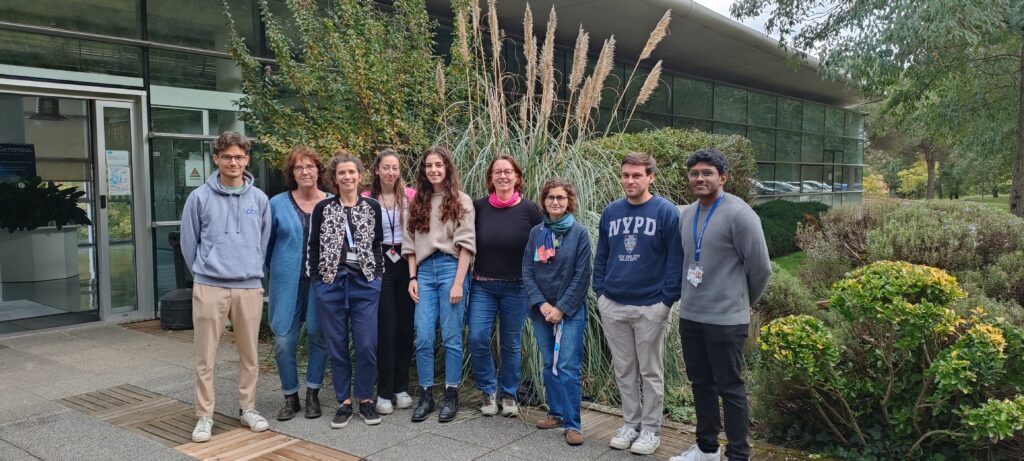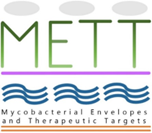Mycobacterial Envelopes and Therapeutic Targets

Group Leader
The main objective of our research group is the characterization of potential drug targets, from their identification to deciphering their mechanisms of action and roles in physiology and infection, for application in the context of improving anti-tuberculosis therapy. Our research includes better understanding of metabolic pathways and enzymes involved in cell envelope lipid biogenesis and in virulence mechanisms in Mycobacteria
Our team focuses on metabolic pathways involved in mycobacterial envelope lipids and on biofilm formation in order to characterize new targets and design innovative therapeutic agents to face antibiotic resistance in mycobacterial infections, notably tuberculosis.

Tuberculosis (TB), caused by Mycobacterium tuberculosis (Mtb), is one of the leading causes of death worldwide. The rise in drug resistance highlights the urgent need to identify new therapeutic targets and develop innovative strategies, with novel chemical families of drugs and new mechanisms of action.
The team interest is mainly in the physiology of mycobacteria, including non-tuberculous mycobacteria, with a focus on understanding and targeting enzymes involved in the biosynthesis of lipidic components of mycobacterial cell envelopes. The group has expertise in analytical and structural biochemistry of lipids and polysaccharides, molecular microbiology and protein biotechnology. The team develops screening (on whole cells and target-based) assays to discover therapeutic agents and validate targets. In particular, we have initiated and reinforced collaborations with chemistry groups to identify, validate and valorise original, innovative molecules.
We use interdisciplinary approaches, in collaboration with our partners, to develop various aspects of early-stage drug discovery, ranging from identification to exploitation of promising anti-mycobacterial targets with significant pharmaceutical interest to develop novel molecules with unexplored modes of action.
Targeting enzymes involved in cell envelope biosynthesis has been of major interest for anti-TB drug discovery. Our approach is illustrated through the study of a potential target, involved in the biosynthesis of the cell wall mycolic acids. To validate this protein as a druggable target, we initiated a drug repurposing campaign and screened a collection of approved drugs using a biochemical assay that reads out activity inhibition. These efforts led to discovery of a new pharmacophore, and some of its derivatives as inhibitors with potent in vitro activity against M.tuberculosis.
In the search of new anti-mycobacterial drugs acting through new mechanisms of action, we are evaluating the efficacy potential of a new family of compounds inspired from natural products. Combining both medicinal chemistry and biological evaluations, we perform SAR studies toward selective and effective compounds against M.tuberculosis. Based on a partnership with complementary expertise, we combine multidisciplinary approaches to generate evolved hits, elucidate their mechanism of action and identify their bacterial targets and validate their therapeutic efficacy in vivo.
Many antibiotics against Mtb are prodrugs and need to be converted into their active compounds by mycobacterial enzymes. We are interested in a specific class of prodrug-activating enzymes, by investigating their biochemical and structural features. The optimization of protein expression and purification conditions led to improved purification yields with highly pure proteins suitable for enzymatic and structural studies. Based on enzymatic assays, we charactertised the selectivity for various substrates, which was confirmed by in silico docking of the substrates via structural models generated by homology.
Team members
Research Scientists
Hedia Marrakchi (CNRS)
Anne Lemassu (University)
Research Engineers
Patricia Constant (CNRS)
Leïla Mefoum
PhD Students
Martin Campoy
Chloé Garcia
Chérine Mehalla
Rathies Ravindra
Master students
Matthieu Delogeau
Yohan Tapin
Bannatine et al. (2025) Genome Mining and Chermistry-Driven Discovery of a Cell Wall Lipopeptide Signature for Mycobacterium avium subsp. paratuberculosis Ancestral Lineage ACS Infect. Dis.
Tomas*, Leonelli* et al. (2022) Bioinformatic Mining and Structure-Activity Profiling of Baeyer-Villiger Monooxygenases from Mycobacterium tuberculosis. mSphere
Le et al. (2022) Drug screening approach against mycobacterial fatty acyl-AMP ligase FAAL32 renews the interest of the salicylanilide pharmacophore in the fight against tuberculosis. Bioorg Med Chem
Lanéelle et al. (2021) Lipid and Lipoarabinomannan Isolation and Characterization. Methods Mol Biol
Le et al. (2020) The protein kinase PknB negatively regulates biosynthesis and trafficking of mycolic acids in mycobacteria. J Lipid Res
Daffé, Marrakchi (2019) Unraveling the Structure of the Mycobacterial Envelope. Microbiol Spectr

Collaborations
International
- Daniela Megrian (Institut Pasteur de Montevideo, Uruguay)
- Matthias Wilmanns (EMBL Hamburg, Germany)
- Przemyslaw Plocinski (University of Lodz, Poland)
- Roberta Provvedi & Riccardo Manganelli (University of Padova, Italy)
- Jana Korduláková & Katarina Mukosova (Comenius University, Bratislava, Slovak Republic)
- Véronique Fontaine (Université Libre de Bruxelles)
- Gérald Larrouy-Maumus (Imperial College, London, UK)
- Imourana Kpembi Alassane & Jérôme del Castillo (Université de Montréal)
- Parvinder Kaur (Foundation for Neglected Disese Research FNDR)
National
- Gwenaëlle André (MaiAGE, INRAE, Jouy-en-Josas)
- Anne Marie Wehenkel & Pedro Alzari (Institut Pasteur, Paris)
- Roland Brosch (Institut Pasteur, Paris)
- Alain Baulard ; Nicolas Willand (Institut Pasteur Lille/Université de Lille)
- Pierre Verhaeghe (Université Grenoble Alpes)
- Caroline Castera-Ducros & Nicolas Primas (Aix-Marseille Université)
- Virginie Molle (Université de Montpellier)
- Franck Biet (UMR Infectiologie et Santé Publique, INRAE Tours-Nouzilly)
Local
- Fatima El Garah (LGC, UPR 5503)
- Vania Bernardes-Génisson & Valérie Maraval (LCC, UPR 8241)
- Yves Génisson & Stéphanie Ballereau (SPCMIB, UMR5068)
- Lionel Mourey, Valérie Guillet & Laurent Maveyraud (IPBS)
- Odile Schiltz (IPBS)
- Sébastien Britton (IPBS)
- PICT platform (IPBS)
- ProteoToul (IPBS)
- Olivier Saurel/Andrew Atkinson (IPBS)
Funding
Our team is or has been supported in the five past years by grants or fellowships from:
- Agence Nationale de la Recherche (ANR)
- ANRS-Maladies Infectieuses Emergentes (ANRS|MIE)
- MSDAvenir
- Mission pour les Initiatives Transverses et Interdisciplinaires CNRS 80 PRIME and « Modélisation du Vivant »Université Paul Sabatier de Toulouse
- Fondation Roland Garrigou (Fonroga)
- Partenariat Hubert Curien (PHC) | Campus France
- Université de Toulouse
The complete list of our publications is available through Pubmed.
Bannantine, J., Etienne, G., Lemassu, A., Cochard, T., Ganneau, C., Melo, S., Conde, C., Marrakchi, H., Bay, S and Biet F. (2025). Genome mining and chemistry-driven discovery of a cell wall lipopeptide signature for Mycobacterium avium subsp. paratuberculosis ancestral lineage. ACS Infect Dis 11(6):1635-1647 (view)
Bories, P., Rima, J., Tranier, S., Marcoux, J., Grimoire, Y., Tomaszczyk, M., Launay, A., Fata, K., Marrakchi, H., Burlet-Schiltz, O., Mourey, L., Ducoux-Petit, M., Bardou, F., Bon, C., and Quémard, A. (2024). HadBD dehydratase from Mycobacterium tuberculosis fatty acid synthase type II: A singular structure for a unique function. Protein Science. 33(4), e4964. (view)
Adande, K., Simalou, O., Ardanuy, J., Eloh, K., Mehalla, C., Constant, P., Fabing, I., Génisson, Y., and Ballereau, S. (2024). Synthesis and biological evaluation of natural Lachnophyllum methyl ester, Lachnophyllum lactone and their synthetic analogs. Org. Biomol. Chem. 22, 8010-8023. (view)
Pinotsis, N., Krüger, A., Tomas, N., Chatziefthymiou, S., Litz, C., Mortensen, S., Daffé, M., Marrakchi, H., Antranikian, G., and Wilmanns, M. (2023). Discovery of a non-canonical prototype long-chain monoacylglycerol lipase through a structure-based endogenous reaction intermediate complex. Nat. Commun. 14, 7649. (view)
Zhou, Z., Wattiez, R., Constant, P., Marrakchi, H., Soetaert, K., Mathys, V., Fontaine, V., and Zeng, S. (2023). Telacebec Interferes with Virulence Lipid Biosynthesis Protein Expression and Sensitizes to Other Antibiotics. Microorganisms. 11, 2469. (view)
Chebaiki, M., Delfourne, E., Tamhaev, R., Danoun, S., Rodriguez, F., Hoffmann, P., Grosjean, E., Goncalves, F., Azéma-Despeyroux, J., Pál, A., Korduláková, J., Preuilh, N., Britton, S., Constant, P., Marrakchi, H., Maveyraud, L., Mourey, L., and Lherbet, C. (2023). Discovery of new diaryl ether inhibitors against Mycobacterium tuberculosis targeting the minor portal of InhA. Eur J Med Chem. 259, 115646. (view)
Tomas*, N., Leonelli*, D., Campoy, M., Marthey, S., Le, N.-H., Rengel, D., Martin, V., Pál, A., Korduláková, J., Eynard, N., Guillet, V., Mourey, L., Daffé, M., Lemassu*, A., André, G*., Marrakchi*, H. (2022). Bioinformatic Mining and Structure-Activity Profiling of Baeyer-Villiger Monooxygenases from Mycobacterium tuberculosis. MSphere, e0048221 (view)
Le, N.-H., Constant, P., Tranier, S., Nahoum, V., Guillet, V., Maveyraud, L., Daffé, M., Mourey, L., Verhaeghe, P., Marrakchi, H. (2022). Drug screening approach against mycobacterial fatty acyl-AMP ligase FAAL32 renews the interest of the salicylanilide pharmacophore in the fight against tuberculosis. Bioorganic & Medicinal Chemistry, 71, 116938 (view)
Boldrin, F., Cioetto Mazzabò, L., Lanéelle, M.-A., Rindi, L., Segafreddo, G., Lemassu, A., Etienne, G., Conflitti, M., Daffé, M., Garzino Demo, A., Manganelli, R., Marrakchi, H., Provvedi, R. (2022). LysX2 is a Mycobacterium tuberculosis membrane protein with an extracytoplasmic MprF-like domain. BMC Microbiology 22, 85 (view)
Schahl, A., Lemassu, A., Jolibois, F., Réat, V. (2022). Evidence for amylose inclusion complexes with multiple acyl chain lipids using solid-state NMR and theoretical approaches. Carbohydrate Polymers 276, 118749 (view)
Lanéelle, M.-A., Spina, L., Nigou, J., Lemassu, A., Daffé, M. (2021). Lipid and Lipoarabinomannan Isolation and Characterization. Methods in Molecular Biology (Clifton, N.J.) 2314, 109–150 (view)
Le, N.-H., Locard-Paulet, M., Stella, A., Tomas, N., Molle, V., Burlet-Schiltz, O., Daffé, M., Marrakchi, H. (2020). The protein kinase PknB negatively regulates biosynthesis and trafficking of mycolic acids in mycobacteria. Journal of Lipid Research, 61(8), 1180–1191 (view)
Eynard, N., Daffé, M., Brosch, R., Quémard, A. (2020). Discovery of a novel dehydratase of the fatty acid synthase type II critical for ketomycolic acid biosynthesis and virulence of Mycobacterium tuberculosis. Scientific Reports 10, 2112 (view)
Zeng, S., Constant, P., Yang, D., Baulard, A., Lefèvre, P., Daffé, M., Wattiez, R., Fontaine, V. (2019). Cpn60.1 (GroEL1) Contributes to Mycobacterial Crabtree Effect: Implications for Biofilm Formation. Frontiers in Microbiology 10, 1149 (view)
Daffé, M., Marrakchi, H. (2019). Unraveling the Structure of the Mycobacterial Envelope. Microbiology Spectrum 7 (view)
Madacki, J., Laval, F., Grzegorzewicz, A., Lemassu, A., Záhorszká, M., Arand, M., McNeil, M., Daffé, M., Jackson, M., Lanéelle, M.-A., Korduláková, J. (2018). Impact of the epoxide hydrolase EphD on the metabolism of mycolic acids in mycobacteria. The Journal of Biological Chemistry 293, 5172–5184 (view)
Lefebvre, C., Boulon, R., Ducoux, M., Gavalda, S., Laval, F., Jamet, S., Eynard, N., Lemassu, A., Cam, K., Bousquet, M.-P., Bardou, F., Burlet-Schiltz, O., Daffé, M., Quémard, A. (2018). HadD, a novel fatty acid synthase type II protein, is essential for alpha- and epoxy-mycolic acid biosynthesis and mycobacterial fitness. Scientific Reports 8, 6034 (view)
Bannantine, J. P., Etienne, G., Laval, F., Stabel, J. R., Lemassu, A., Daffé, M., Bayles, D. O., Ganneau, C., Bonhomme, F., Branger, M., Cochard, T., Bay, S., Biet, F. (2017). Cell wall peptidolipids of Mycobacterium avium: From genetic prediction to exact structure of a nonribosomal peptide. Molecular Microbiology 105, 525–539 (view)
Bazet Lyonnet, B., Diacovich, L., Gago, G., Spina, L., Bardou, F., Lemassu, A., Quémard, A., Gramajo, H. (2017). Functional reconstitution of the Mycobacterium tuberculosis long-chain acyl-CoA carboxylase from multiple acyl-CoA subunits. The FEBS Journal 284, 1110–1125 (view)
Issa, H., Huc-Claustre, E., Reddad, T., Bonadé Bottino, N., Tropis, M., Houssin, C., Daffé, M., Bayan, N., Dautin, N. (2017). Click-chemistry approach to study mycoloylated proteins: Evidence for PorB and PorC porins mycoloylation in Corynebacterium glutamicum. PloS One 12, e0171955 (view)
Carel, C., Marcoux, J., Réat, V., Parra, J., Latgé, G., Laval, F., Demange, P., Burlet-Schiltz, O., Milon, A., Daffé, M., Tropis, M. G., Renault, M. A. M. (2017). Identification of specific posttranslational O-mycoloylations mediating protein targeting to the mycomembrane. Proceedings of the National Academy of Sciences of the United States of America 114, 4231–4236 (view)
Chiaradia, L., Lefebvre, C., Parra, J., Marcoux, J., Burlet-Schiltz, O., Etienne, G., Tropis, M., Daffé, M. (2017). Dissecting the mycobacterial cell envelope and defining the composition of the native mycomembrane. Scientific Reports 7, 12807 (view)
Daffé, M. (2015). The cell envelope of tubercle bacilli. Tuberculosis (Edinburgh, Scotland), 95 Suppl 1, S155-158 (view)
Boritsch, E. C., Frigui, W., Cascioferro, A., Malaga, W., Etienne, G., Laval, F., Pawlik, A., Le Chevalier, F., Orgeur, M., Ma, L., Bouchier, C., Stinear, T. P., Supply, P., Majlessi, L., Daffé, M., Guilhot, C., Brosch, R. (2016). Pks5-recombination-mediated surface remodelling in Mycobacterium tuberculosis emergence. Nature Microbiology 1, 15019 (view)
Guillet, V., Galandrin, S., Maveyraud, L., Ladevèze, S., Mariaule, V., Bon, C., Eynard, N., Daffé, M., Marrakchi, H., Mourey, L. (2016). Insight into Structure-Function Relationships and Inhibition of the Fatty Acyl-AMP Ligase (FadD32) Orthologs from Mycobacteria. The Journal of Biological Chemistry 291, 7973–7989 (view)
Le, N.-H., Molle, V., Eynard, N., Miras, M., Stella, A., Bardou, F., Galandrin, S., Guillet, V., André-Leroux, G., Bellinzoni, M., Alzari, P., Mourey, L., Burlet-Schiltz, O., Daffé, M., Marrakchi, H. (2016). Ser/Thr Phosphorylation Regulates the Fatty Acyl-AMP Ligase Activity of FadD32, an Essential Enzyme in Mycolic Acid Biosynthesis. The Journal of Biological Chemistry 291, 22793–22805 (view)
Burbaud, S., Laval, F., Lemassu, A., Daffé, M., Guilhot, C., Chalut, C. (2016). Trehalose Polyphleates Are Produced by a Glycolipid Biosynthetic Pathway Conserved across Phylogenetically Distant Mycobacteria. Cell Chemical Biology 23, 278–289 (view)
Slama, N., Jamet, S., Frigui, W., Pawlik, A., Bottai, D., Laval, F., Constant, P., Lemassu, A., Cam, K., Daffé, M., Brosch, R., Eynard, N., Quémard, A. (2016). The changes in mycolic acid structures caused by hadC mutation have a dramatic effect on the virulence of Mycobacterium tuberculosis. Molecular Microbiology 99, 794–807 (view)
Jamet, S., Quentin, Y., Coudray, C., Texier, P., Laval, F., Daffé, M., Fichant, G., Cam, K. (2015). Evolution of Mycolic Acid Biosynthesis Genes and Their Regulation during Starvation in Mycobacterium tuberculosis. Journal of Bacteriology 197, 3797–3811 (view)
Jamet, S., Slama, N., Domingues, J., Laval, F., Texier, P., Eynard, N., Quémard, A., Peixoto, A., Lemassu, A., Daffé, M., Cam, K. (2015). The Non-Essential Mycolic Acid Biosynthesis Genes hadA and hadC Contribute to the Physiology and Fitness of Mycobacterium smegmatis. PloS One 10, e0145883 (view)
Ehebauer, M. T., Zimmermann, M., Jakobi, A. J., Noens, E. E., Laubitz, D., Cichocki, B., Marrakchi, H., Lanéelle, M.-A., Daffé, M., Sachse, C., Dziembowski, A., Sauer, U., Wilmanns, M. (2015). Characterization of the mycobacterial acyl-CoA carboxylase holo complexes reveals their functional expansion into amino acid catabolism. PLoS Pathogens 11, e1004623 (view)
Daffé, M., Crick, D. C., Jackson, M. (2014). Genetics of Capsular Polysaccharides and Cell Envelope (Glyco)lipids. Microbiology Spectrum 2, MGM2-0021–2013 (view)
Marrakchi, H., Lanéelle, M.-A., Daffé, M. (2014). Mycolic acids: Structures, biosynthesis, and beyond. Chemistry & Biology 21, 67–85 (view)
Moura-Alves, P., Faé, K., Houthuys, E., Dorhoi, A., Kreuchwig, A., Furkert, J., Barison, N., Diehl, A., Munder, A., Constant, P., Skrahina, T., Guhlich-Bornhof, U., Klemm, M., Koehler, A.-B., Bandermann, S., Goosmann, C., Mollenkopf, H.-J., Hurwitz, R., Brinkmann, V., Fillatreau, S., Daffé, M., … Kaufmann, S. H. E. (2014). AhR sensing of bacterial pigments regulates antibacterial defence. Nature 512, 387–392 (view)
Rienksma, R. A., Suarez-Diez, M., Spina, L., Schaap, P. J., Martins dos Santos, V. A. P. (2014). Systems-level modeling of mycobacterial metabolism for the identification of new (multi-)drug targets. Seminars in Immunology 26, 610–622 (view)
Gavalda, S., Bardou, F., Laval, F., Bon, C., Malaga, W., Chalut, C., Guilhot, C., Mourey, L., Daffé, M., Quémard, A. (2014). The polyketide synthase Pks13 catalyzes a novel mechanism of lipid transfer in mycobacteria. Chemistry & Biology 21, 1660–1669 (view)
Galandrin, S., Guillet, V., Rane, R. S., Léger, M., N, R., Eynard, N., Das, K., Balganesh, T. S., Mourey, L., Daffé, M., Marrakchi, H. (2013). Assay development for identifying inhibitors of the mycobacterial FadD32 activity. Journal of Biomolecular Screening 18, 576–587 (view)
Gavalda, S., Léger, M., van der Rest, B., Stella, A., Bardou, F., Montrozier, H., Chalut, C., Burlet-Schiltz, O., Marrakchi, H., Daffé, M., Quémard, A. (2009). The Pks13/FadD32 crosstalk for the biosynthesis of mycolic acids in Mycobacterium tuberculosis. The Journal of Biological Chemistry 284, 19255–19264 (view)
Lefebvre, C., Frigui, W., Slama, N., Lauzeral-Vizcaino, F., Constant, P., Lemassu, A., Parish, T., Léger, M., Gavalda, S., Guillet, V., van der Rest, B., Slama, N., Montrozier, H., Mourey, L., Quémard, A., Daffé, M., Marrakchi, H. (2009). The dual function of the Mycobacterium tuberculosis FadD32 required for mycolic acid biosynthesis. Chemistry & Biology 16, 510–519 (view)
- Dimitri Leonelli, ATER lecturer, University of Toulouse
- Pascaline Bories-Lafont, post-doctoral fellow, CHU Québec-Université Laval, Quebec
- Nicolas Tomas, post-doctoral fellow, TWB, France
- Laura Chiaradia, Analytical Engineer, Centre Hospitalier Territorial, New Caledonia
- Nguyen-Hung Le, post-doctoral fellow, Marseille, France
- Richard Boulon, post-doctoral fellow, INRS institute, Quebec
- Cyril Lefebvre, Unit Manager, Dubernet Rhône, France
- Mathieu Leger, Quality Manager, iNOVie, France
- Ségolène Galandrin, Project Manager, CHU, France
- Brahim Saffiedine, Product Manager, Senegal
- Sabine Gavalda, Biophysics Engineer, Carbios, France
- Julien Vaubourgeix, INSERM research scientist
- Tounkang Sambou, Unit Manager, Senegal
- Nawel Slama, Project Manager, TWB, France
- Emilie Huc, Research Scientist, Evotec, France
- Premkumar Dinadayala, Research Scientist, Evotec, France
- Emmanuelle Sacco, Clinical Research Project Manager, CHU, France
- Jean-Clément Mars, Post-doctoral fellow, Laval, Québec

